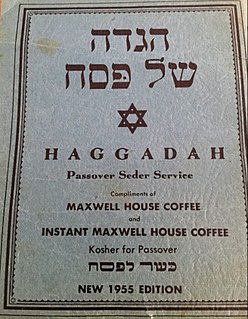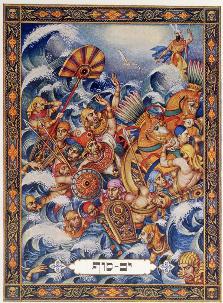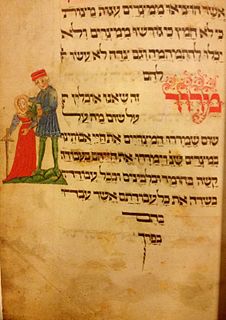 W
WThe Haggadah is a Jewish text that sets forth the order of the Passover Seder. Reading the Haggadah at the Seder table is a fulfillment of the mitzvah to each Jew to "tell your son" of a story from the Book of Exodus about Israelites being delivered from slavery, involving an Exodus from Egypt through the hand of Yahweh in the Torah.
 W
WThe Birds' Head Haggadah is the oldest surviving illuminated Ashkenazi Passover Haggadah. The manuscript, produced in the Upper Rhine region of Southern Germany in the early 14th century, contains the full Hebrew text of the Haggadah, a ritual text recounting the story of Passover – the liberation of the Israelites from slavery in ancient Egypt – which is recited by participants at a Passover Seder. The text is executed in block calligraphy and accompanied by colorful illustrations of Jews performing the Seder practices and reenacting Jewish historical events. The Birds' Head Haggadah is so called because all Jewish men, women, and children depicted in the manuscript have human bodies with the faces and beaks of birds. Non-Jewish and non-human faces are blank or blurred. Numerous theories have been advanced to explain the unusual iconography, usually tied to Jewish aniconism. The Haggadah is in the possession of the Israel Museum in Jerusalem, where it is on permanent exhibition.
 W
WThe Golden Haggadah is an illuminated manuscript originating around c. 1320-1330 in the region of Catalonia. It is an example of an Illustrated Haggadah, a religious text for Jewish Passover. It contains many lavish illustrations in the High Gothic style with Italianate influence, and is perhaps one of the most distinguished illustrated manuscripts created in Spain. The Golden Haggadah currently resides in the British Library and can be fully viewed as part of their Digitized Manuscript Collection MS 27210.
 W
WHa Lachma Anya is a declaration that is recited at the beginning of the Magid portion of the Passover Seder. Written in Aramaic, the recitation serves as the first explanation of the purpose of the matzo during the Seder.
 W
WThe Maxwell House Haggadah is an English-Hebrew Passover Haggadah introduced by the Maxwell House company as a marketing promotion in 1932 and printed continuously since that time. With over 50 million copies in print, it is the best known and most popular Haggadah among American Jews, and is considered a cultural icon. It is used at Passover Seders in homes, schools, senior centers, prisons, and the United States Army, and was the edition used by President Obama and his guests at the White House Passover Seder conducted yearly from 2009 to 2016. In 2011 a new English translation replaced archaic phrases in the original and also incorporated gender-neutral language.
 W
WThe Sarajevo Haggadah is an illuminated manuscript that contains the illustrated traditional text of the Passover Haggadah which accompanies the Passover Seder. It is one of the oldest Sephardic Haggadahs in the world, originating in Barcelona around 1350. The Haggadah is owned by the National Museum of Bosnia and Herzegovina in Sarajevo. Its monetary value is undetermined, but a museum in Spain required that it be insured for $7 million before it could be transported to an exhibition there in 1992.
 W
WThe Szyk Haggadah is a Passover Haggadah that was illustrated by the Polish-Jewish artist Arthur Szyk in Poland between 1934 and 1936. Szyk's visual commentary on the ancient story of Passover uses the vocabulary and format of an illuminated manuscript; each of his 48 full-page watercolor and gouache illuminations contains the traditional text of the Haggadah, which is clarified and interpreted by the images and symbols on the same page.
 W
WThe Washington Haggadah is a Hebrew-language illuminated manuscript haggadah created by Joel ben Simeon in 1478. He was a specialist illuminator of haggadot, who seems to have worked in both Italy and Germany, and whose style shows influences from the contemporary art of both countries.